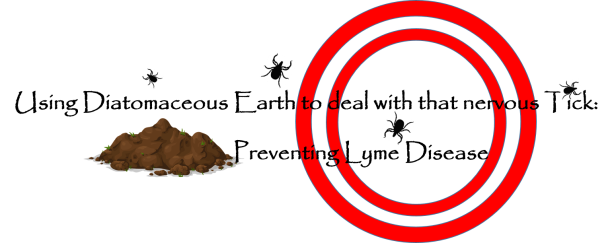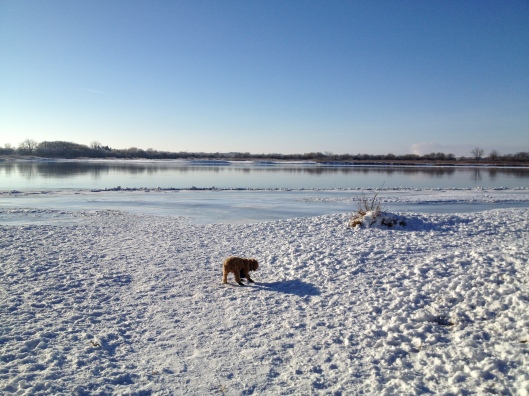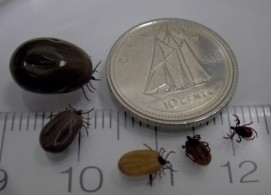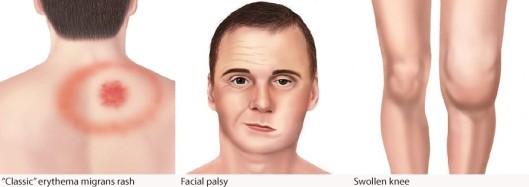
Did you know that you can repel and even kill ticks and other pesky bugs with dust? Diatomaceous Earth is a type of dust that has specific properties that can suffocate and repel ticks and other insects. First, this paper will look at where the tick originated and its habitat. Second, black-legged or deer ticks can transmit Lyme disease and ways to prevent and treat it will be examined. Finally, a new natural remedy – the use of diatomaceous earth – will be covered.

Emerging in the United States in the 1970s, ticks have expanded into Canada due to warm weather caused by climate change (Levy, 2014), growing deer populations, and suburban growth (Beard, 2014). These factors have brought ticks into towns, cities, parks, and homes. With a growing population of ticks throughout North America, an epidemic could be possible with the chance of a super El Niño occurring in 2015. According to Sutherland (2015), an El Niño that peaks in fall/winter of typically brings warmer, drier weather to Western Canada, however if it peaks in summer we may have a winter that might be worse than 2014.
Here in Saskatchewan, ticks are becoming a nuisance as soon as the snow melts. My dogs are now six years old and over the years we have become frequent visitors of the many lush off-leash dog parks in the area. Many of these parks are beautiful, like little forests within the city limits, always a scenic view all year round. A major feature of most of the parks is that the river is a treat for the dogs in the hot summer months. However, as soon as the snow begins to melt in March, ticks are starting to appear all over the city of Saskatoon, especially by the river, in heavily wooded areas and fields with tall grass (Streck, 2015). Although the majority of ticks identified in Saskatchewan are the dog tick, the Black-legged or deer tick has been spotted (0.3%) most likely carried by migrating birds (Government of Saskatchewan, 2015).
Worst of all the bugs that my dogs and I have encountered is the tick. This creepy crawler is part of the spider family and can be very small and hard to see. It is important to be aware of these tiny insects, as the black-legged or deer tick can transmit Lyme disease to humans (Levy, 2014). Dogs are often bitten by ticks more frequently than humans, however they rarely present with clinical symptoms of Lyme disease (Bouchard, Leonard, Koffi, Pelcat, Peregrine, Chilton, and Ogden, 2015).
It is important to be aware of the symptoms of Lyme disease as medical treatment must be sought promptly. Symptoms of Lyme disease in humans include: bulls-eye rash, fever, chills, headache, fatigue, muscle and joint aches, and swollen lymph nodes, within 3-30 days; long-term symptoms include facial movement disorders, inflammation of the heart, dizziness or shortness of breath, arthritis, pain in tendons, muscles, joints, bones, and nerves, and short-term memory problems (Centers for Disease Control and Prevention, 2015). To prevent transition of the disease it is important to remove the tick within 24 hours of being bitten (Levy, 2014). If medical treatment is not obtained within 2-4 weeks long-term consequences such as persistent fatigue, breathing problems, muscle aches, and short-term memory problems may occur (Beard, 2014).
According to Beard (2014), the symptoms of Lyme disease present differently in dogs and appear later (2-5 months after exposure). Dogs are more likely to experience fever, anorexia, depression, extreme tiredness, sudden or recurrent lameness, joint swelling, muscle pain, arthritis, and swollen lymph nodes (Bouchard et. al., 2015). Furthermore, treatment for Lyme disease differs in dogs as there is a vaccine for animals, but not for humans (Bouchard et. al., 2015).
It is important to prevent being bitten by ticks, various methods include cleaning up landscapes, tick checks, showering after being in the forest or by the river (Beard, 2014). Other tips include wearing closed-toe shoes, long-sleeved shirts and pants, light coloured clothing to spot ticks easier, pulling your socks over your pant legs, applying repellants or toxicants to skin or clothing containing DEET, and when hiking stay on paths and avoid contact with overgrown brush (Government of Saskatchewan, 2015).
To deal with Lyme disease the action plan of the Public Health Agency of Canada is built upon three ideas: 1) education and awareness, 2) observation, prevention and control, and 3) research and outcome (Harymann, Ogden, Lindsay, Lawless, Deilgat, and Sternthal, 2014). However, according to Hill (2012) Lyme disease is not among those diseases that are internationally notifiable, it is reported on a province by province basis; only if it is a high risk area or there happens to be an outbreak. This failure in mandatory public health reporting by physicians is due to several factors including lack of knowledge regarding diagnosing Lyme disease, confusion as to which diseases are reportable, and how and whom to report the disease to (Hill, 2012).
This means that there may be more cases of Lyme disease in Saskatchewan than are reported and the disease may be misdiagnosed. The risk of contracting Lyme disease may be higher than reported. Considering that different regions across Canada vary in their risk of contracting Lyme disease, preventative actions should be taken when necessary (Bouchard et. al., 2015). There are multiple measures to deal with ticks for both humans and dogs. The best way to prevent coming into contact with tick and Lyme disease is to avoid tall grass, trees, bushes, and dead piles of leaves, until late-fall (October) (Bouchard et. al., 2015).

Figure 1: Adamson, L. (photographer). (2014). Chief Whitecap Park [Photograph], Retrieved November 15, 2015. Photograph of Casie and Kiya in Chief Whitecap Park, Saskatoon, Sk.
As an avid dog walker, this was not an option so I began to take multiple precautions to deal with ticks every year. After the snow melts and the bugs start to appear my dogs are rounded up and a topical anti-tick product is applied. I try to find an anti-tick product that not only kills ticks after they latch on, but also repels them and other pesky bugs like mosquitos. Second, my dogs are shaved down to a bare minimum amount of fur (to protect them from the heat and sun), so that the ticks are easy to spot and remove. Third, I find the tweezers – for the car, home, and in the purse – as ticks appear in the strangest places. Fourth, to clean the bite from a tick and prevent Lyme disease use an anti-bacterial medicine (I use Polysporin or tea-tree oil), after cleaning the bite mark with rubbing alcohol. Finally, and most importantly, I use Diatomaceous Earth to repel and kill ticks.
Diatomaceous earth has become a life saver, it is a naturally occurring dust that is made up of fossils of algae, and it is effective against insects with stiff hair or rough surfaces on their bodies (Shah and Khan, 2014). This dust when present can repel insects, however if bugs – ticks, ants, spiders, bed bugs – happen to crawl in the diatomaceous earth it has properties that smothers bugs. This dust has many beneficial properties that I was looking for in a bug deterrent. It is important to note that not all types of diatomaceous earth are safe, certain types contain crystalline silica which can cause respiratory problems in humans and animals; it is recommended product contain <1% crystalline silica (SPCA, 2007).
Organic diatomaceous earth is non-toxic to mammals (Shah and Khan, 2014), making it safe to use in and around the home, as well as in vehicles. Second, this dust is easy to remove from surfaces (Shah and Khan, 2014). Third, although you may need large amount of the dust cover every area, it is affordable for a large bag. Furthermore, the dust does not expire and only needs to be reapplied after rain or when it gets blown away/cleaned up. Finally, diatomaceous earth can be applied directly to the dog fur to manage tick or even fleas – ensure they don’t inhale a lot of the dust and that they are showered after a couple of days so the skin does not dry out.
Understanding that the population of ticks is growing and that black-legged or deer ticks have been expanding into Canada due to warmer weather patterns is key to mitigating risk of contracting Lyme disease. Multiple methods of prevention and protection should be used when entering the ticks’ habitat, especially checking yourself and pets daily for ticks. Maintaining a tick free environment at home and on the road for your family can be done with the simple use of diatomaceous earth, obtained from a farm and garden store near you, or on amazon.ca.
To help in the research of ticks in Saskatchewan please visit the University of Saskatchewan – Veterinary Clinic for more information on how to submit ticks for identification and testing.
© 2015 Laura Adamson – All Rights Reserved
References
Beard, C. B. (2014). Lyme disease prevention and control–the way forward. Inside this issue, 40, 91.
Bouchard, C., Leonard, E., Koffi, J. K., Pelcat, Y., Peregrine, A., Chilton, Rochon, K., Lysyk, T., Lindsay, L. R., and Ogden, N. H. (2015). The increasing Risk of Lyme Disease in Canada. The Canadian Veterinary Journal, 56, 693-699.
Centers for Disease Control and Prevention. (2015). Lyme disease. Retrieved from: http://www.cdc.gov/lyme/index.html
Hill, A. (2012). Indifferent reporting of notifiable diseases. Canadian Medical Association Journal, 184(10), E513-E514.
Harymann, M., Ogden, N., Lindsay, R., Lawless. V., Deilgat, M., and Sternthal, S. (2014). Summary of the Public Health Agency of Canada’s Action Plan on Lyme disease. Inside this issue, 40, 91.
Government of Saskatchewan (2015). Lyme disease. Retrieved from: https://www.saskatchewan.ca/residents/health/diseases-and-conditions/lyme-disease
Levy, S. (2014). Ticking time bomb? Climate change and Ixodes scapularis. Environmental health perspectives, 122(6), A168.
Shah, M. A., & Khan, A. A. (2014). Use of diatomaceous earth for the management of stored-product pests. International Journal of Pest Management, 60(2), 100-113.
SPCA. (April, 2007). Diatomaceous Earth: Its Use and Precautions. The SPCA Certified Guide. Retrieved from: http://www.spca.bc.ca/assets/documents/welfare/professional-resources/farmer-resources/diatomaceous-earth-factsheet.pdf
Streck, Aaron (May 8, 2015). Tick season comes early to Saskatchewan and is expanding. Global New. Retrieved from: http://globalnews.ca/news/1986552/tick-season-comes-early-to-saskatchewan-and-is-expanding/
Sutherland, Scott. (2015). Update: Is a belated ‘super’ El Niño in the works for 2015? The Weather Network. Retrieved from: http://www.theweathernetwork.com/news/articles/stranger-and-stranger-is-el-nino-2015-in-for-the-long-haul/51103/



![5263275543_7b653ea8e9[1]](https://thegirlwithtoomanyinterests.files.wordpress.com/2015/11/5263275543_7b653ea8e91.jpg?w=502&h=245)
![5261975338_02c31a7470[1]](https://thegirlwithtoomanyinterests.files.wordpress.com/2015/11/5261975338_02c31a74701.jpg?w=529)






